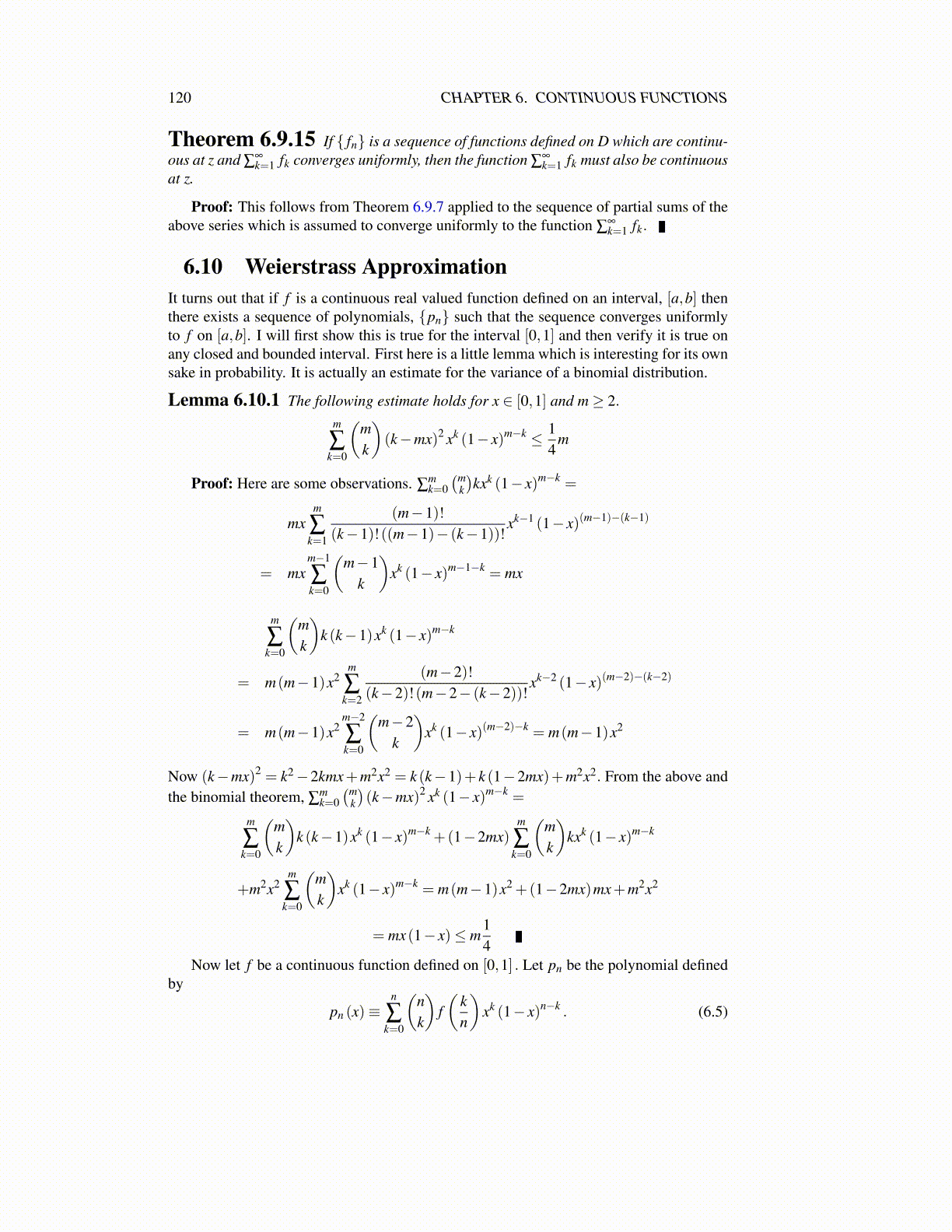
120 CHAPTER 6. CONTINUOUS FUNCTIONS
Theorem 6.10.3 Suppose f is a continuous function defined on [a,b]. Then thereexists a sequence of polynomials, {pn} which converges uniformly to f on [a,b].
Proof: For t ∈ [0,1] , let h(t) = a+(b−a) t. Thus h maps [0,1] one to one and onto[a,b] . Thus f ◦h is a continuous function defined on [0,1] . It follows there exists a sequenceof polynomials {pn} defined on [0,1] which converges uniformly to f ◦h on [0,1]. Thus forevery ε > 0 there exists Nε such that if n≥ Nε , then for all t ∈ [0,1] , | f ◦h(t)− pn (t)|< ε.However, h is onto and one to one and so for all x ∈ [a,b],
∣∣ f (x)− pn(h−1 (x)
)∣∣ < ε.
Now note that the function x→ pn(h−1 (x)
)is a polynomial because h−1 (x) = x−a
b−a . Morespecifically, if pn (t) = ∑
mk=0 aktk it follows
pn(h−1 (x)
)=
m
∑k=0
ak
(x−ab−a
)k
which is clearly another polynomial.
6.11 Ascoli Arzela TheoremThis is a major result which plays the role of the Heine Borel theorem for the set of con-tinuous functions. I will give the version which holds on an interval, although this theoremholds in much more general settings. First is a definition of what it means for a collec-tion of functions to be equicontinuous. In words, this happens when they are all uniformlycontinuous simultaneously.
Definition 6.11.1 Let S ⊆ C ([0,T ]) where C ([0,T ]) denotes the set of functionswhich are continuous on the interval [0,T ] . Thus S is a set of functions. Then S is said tobe equicontinuous if whenever ε > 0 there exists a δ > 0 such that whenever f ∈ S and|x− y|< δ , it follows
| f (x)− f (y)|< ε
The set of functions is said to be uniformly bounded if there is a positive number M suchthat for all f ∈ S,
sup{| f (x)| : x ∈ [0,T ]} ≤M
Then the Ascoli Arzela theorem says the following in which it is assumed the functionshave values in F although this could be generalized.
Theorem 6.11.2 Let { fn}∞
n=1 ⊆ C ([0,T ]) be uniformly bounded and equicontinu-ous. Then there exists a uniformly Cauchy subsequence.
Proof: Let ε > 0 be given and let δ correspond to ε/4 in the definition of equicontinu-ity. Let 0= x0 < x1 < · · ·< xn = T where these points are uniformly spaced and the distancebetween successive points is T/n < δ . Then the points { fn (x0)}∞
n=1 is a bounded set in F.By the Heine Borel theorem, there is a convergent subsequence
{fk(0) (x0)
}∞
k(0)=1. Thus{k (0)} denotes a strictly increasing sequence of integers. Then the same theorem impliesthere is a convergent subsequence of this one, denoted as k (1) such that limk(1)→∞ fk(1) (x0)
and limk(1)→∞ fk(1) (x1) both exist. Then take a subsequence of{
fk(1)}
called k (2) suchthat for xi = x0,x1,x2, limk(2)→∞ fk(2) (xi) exists. This can be done because if a sequenceconverges then every subsequence converges also. Continue this way. Denote by {k} the